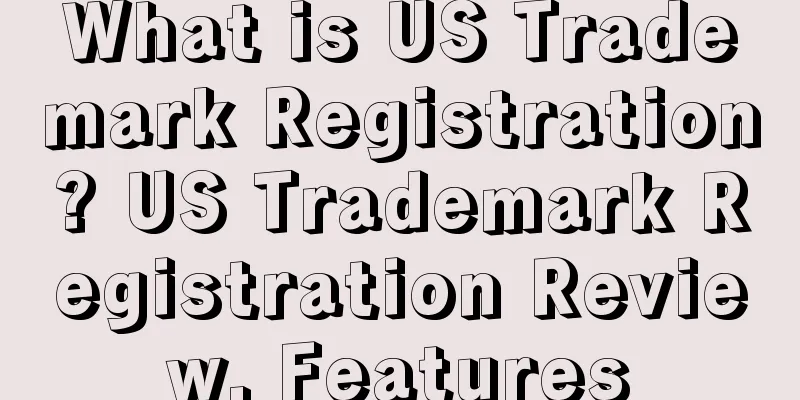What is US Trademark Registration? US Trademark Registration Review, Features

|
The United States adopts the principle of first-to-use trademark protection. The ownership of a U.S. trademark usually depends on the use of the trademark in the United States. Generally speaking, even if the first user has never registered its trademark in the United States or the later user has registered the same or similar trademark, the first user to actually use a trademark has rights superior to the later user. Of course, from the perspective of trademark protection, the registration of the user's trademark with the U.S. Federal Patent and Trademark Office cannot be ignored.
About the Organizations and Trademark Laws of the United States The international organizations and conventions that the United States participates in include the World Intellectual Property Organization, the Paris Convention for the Protection of Industrial Property, the Nice Agreement Concerning the International Classification of Trademarks and Services for the Registration of Trademarks, and the Madrid Protocol. The United States joined the Madrid Protocol on November 2, 2003 and is a pure member of the protocol. The U.S. Congress has also enacted some statutory laws related to trademark registration and protection, including the Federal (Trademark Act) of 1881 and the Third Federal Trademark Act enacted by the U.S. Congress in 1905. The current laws for trademark registration and protection include the Trademark Act, enacted by the U.S. Congress in 1946, commonly known as the Lanham Act. The Act officially came into effect on July 5, 1947, and was amended by the Trademark Act Amendment Act of 1988, which came into effect on November 16, 1989. In addition, relevant regulations include the "Trademark Act Implementing Rules" of October 11, 1989, the "Trademark Counterfeiting Regulations of 1984" that came into effect on October 12, 1984, and the written laws and regulations related to unfair competition and the trademark case practice rules, the 1995 "Federal Trademark Dilution Act" that came into effect on January 16, 1996, and the Federal Law Part II Act No. 37, which was amended on the basis of the Trademark Case Practice Rules of 1989.
importance Having an R mark is a necessary condition for filing on Amazon in the United States.
US Trademark Description There are two levels of registered trademarks in the United States: state and federal. Amazon Brand Registry requires sellers to have a federal registered trademark, which needs to be registered with the United States Patent and Trademark Office (USPTO). Anyone (including non-US citizens) can submit a trademark registration application to the USPTO for free.
U.S. Trademark Administration If you want to apply for a U.S. trademark, you should first know the U.S. Patent and Trademark Office (USPTO), which is responsible for trademark matters. It is affiliated with the Department of Commerce and mainly grants patents to protect inventions and registers trademarks to protect signs used in goods and services. It promotes the interests of global companies (as long as they operate and sell in the United States) and consumers, and strongly strengthens economic development.
US Trademark Categories Under U.S. law, a trademark is a word, name, symbol, design, or combination thereof used to indicate the source of goods or services, including trademarks, service marks, collective marks, and certification marks. The categories of US trademarks are: 1. Trademark: It is a product mark that distinguishes the applicant's products from similar products manufactured or sold by other manufacturers. 2. Service mark: refers to a mark that distinguishes someone's services, including a unique service, from the services of others. 3. Collective mark: a trademark or service mark used by members of a company, association or other groups and organizations. 4. Certification mark: It is a mark that proves that the goods or services provided by others have certain characteristics. These characteristics include: the geographical or other origin of the goods or services, the materials used in the goods, the way the goods are made, the quality and accuracy of the goods or services, or the goods or services are made or provided by members of a certain association or organization. Individuals, countries, states and cities can apply for and obtain registration.
How to apply for a trademark The application of a US trademark is usually completed by an attorney who specializes in intellectual property. Submitting a trademark application to the USPTO is likely to involve complex legal procedures and require the applicant to comply with all requirements of trademark laws, including the legality of the trademark. Individual applicants usually do not understand the specific requirements of trademark law, so a professional attorney is needed to complete the corresponding process. Of course, applicants can also find corresponding foreign-related agents in China and complete the corresponding trademark application operations through foreign-related agents. In fact, most domestic applicants apply for US trademarks in this way. After all, it is a considerable expense to contact a private US lawyer and complete the trademark application.
U.S. Trademark Application Materials 1. Evidence of use: 8-10 pictures of different products printed with the trademark. The product pictures should be named with the product name. 2. Certification: Individual applicants need to submit a copy or scanned copy of their ID card; company applicants need to submit an electronic copy or scanned copy of their business license. 3. Product name and category.
Eligibility 1. Anyone who has used a trademark in the United States can apply for trademark registration. 2. Anyone who intends to use a trademark in the United States can also apply for trademark registration.
Review process Intended use: application – acceptance – examination – announcement – submission of use evidence – registration – issuance of certificate. Actual use: application (submission of use evidence) – acceptance – examination – announcement – registration – issuance of certificate.
Time required 1. Official receipt time: 1 week; 2. Based on use in the United States: 10 months to obtain the certificate; 3. Based on other basis: obtain the certificate in 12 months.
The system of principal and auxiliary books 1. Registration of trademarks in the principal register Obtaining a trademark registration on the USPTO Principal Register will provide the best protection for defending your brand. There are many benefits to registering on the Principal Register, including: (1) After a trademark is approved for registration, it is presumed that the registrant has used the trademark nationwide since the date of filing the trademark registration application; (2) presumption of the validity of the mark, the registrant's ownership of the mark, and the registrant's exclusive right to use the mark nationwide in connection with the products and services it designates; (3) Restricting the scope of use of the same or similar trademark by others before the trademark is registered, that is, other owners of the same or similar trademarks can only use their own trademarks within the original scope; (4) After a trademark is approved for registration, no one may use an identical or similar trademark that may cause confusion among consumers; (5) obtain injunctive relief and recovery of interest, damages, and costs in federal court proceedings, and in some cases increase damages and attorneys' fees; (6) Obtain the right to register with the U.S. Customs and Border Protection to monitor and prevent the importation of products bearing infringing marks; (7) Criminal penalties may be imposed for counterfeiting registered trademarks. However, not all marks can be registered in the principal register. The conditions for trademarks to be registered in the principal register are: the trademark itself has distinctiveness; or it originally did not have distinctiveness but has acquired a secondary meaning through extensive use*, thereby being able to identify the source of goods or services. Section 1052 of the Lanham Act specifies marks that cannot or should not be directly registered on the principal register, including: (1) The identification is primarily and solely of the surname; (2) A mark that is similar to a previously registered or used trademark and may cause confusion among consumers; (3) Immoral and derogatory marks; (4) Deceptive markings; (5) Descriptive identification; (6) A geographical indication indicating the place of origin of wine or liquor, but the wine or liquor concerned does not originate from the area indicated by the geographical indication; (7) Any logo containing the flag, uniform, or emblem of the United States, its states, cities, or foreign governments; (8) any mark containing the name, likeness, or signature of any living individual, unless the written consent of that individual is obtained; (9) Any mark containing the name, signature, or likeness of any deceased President of the United States during the lifetime of such widow, unless the written consent of such widow is obtained. 2. Supplementary registration of trademarks The difference between the principal register and the supplementary register is mainly in the requirement for distinctiveness. Some marks, such as surnames, descriptive marks, etc., although not currently identifiable, may acquire secondary meanings through substantial use and promotion* and may be registered on the supplementary register. Although a trademark registered through the Supplementary Register does not enjoy the same legal validity and presumption of ownership as a trademark registered through the Principal Register, there are still benefits to registration, mainly including: (1) It can effectively prevent other confusingly similar trademarks from being registered later; (2) It can be used as a basis for filing foreign trademark applications; (3) The proprietor may use the registration symbol “®” next to the trademark. The trademark to be registered in the supplementary register must be one that the applicant has already used. If the trademark has been used and promoted continuously and exclusively to a certain extent, so that the relevant purchasing groups can easily associate the goods or services bearing the trademark with a single source, you can apply for registration in the principal register. As long as there is substantial and exclusive use of a mark for five consecutive years and relevant evidence is provided, the USPTO will accept sufficient evidence of its distinctiveness. However, additional evidence such as sales reports, advertising expenses, advertising and promotional materials, and evidence of consumer recognition of the mark such as consumer testimony and survey reports are required.
Validity period of trademark registration 1. The validity period of trademark registration and renewal registration before November 17, 1989 is 20 years; however, the validity period of trademark renewal after November 16, 1989 is 10 years. 2. After the Trademark Amendment Act came into effect, i.e. after November 16, 1989, the validity period of trademark registrations approved will be changed to 10 years, starting from the date of registration. The validity period of each renewal is also 10 years. |
<<: What is HTS Coding? HTS Coding Review, Features
Recommend
Search volume soared 28236%, Etsy home products ushered in a big boom
The 2020 epidemic has prompted more consumers to ...
Benefits are coming! Cainiao International Express and ZiNiao Browser help to make money during the peak season
Peak season is in full swing! Hurry and claim the...
Debts as high as $1 billion! The century-old brand filed for bankruptcy for the 8th time
Since last year, news of various big sales and bu...
UPS Releases Fourth Quarter 2020 Earnings
UPS is one of the world's largest package del...
What is urbanambiance? urbanambiance Review, Features
Urbanambiance is a company that specializes in cha...
What is Worry-Free Sellers? Worry-Free Sellers Review, Features
The Seller Worry-Free Team is affiliated to Shenzh...
Huadong Dama plans to raise another 500 million yuan
As the living environment of residents improves, ...
Consumption exploded. In the first hour of Tmall Double 11, over 2,600 brands sold more products than the entire day last year.
In 1 minute, Wuling Hongguang surpassed last year...
What is Guangdong Smart Logistics? Guangdong Smart Logistics Review, Features
Guangdong Smart Logistics (Guangdong Smart Intern...
The biggest shock in the industry in a decade: Amazon's big sellers have been killed one after another, and the amount involved may exceed 100 billion
In the past two months, Amazon has carried out dr...
What is ihomegifts? ihomegifts Review, Features
ihomegift is for all things handmade and custom. C...
What is Brand Ark? Brand Ark Review, Features
Brand Ark is a media dedicated to the research of...
Pinterest adds live streaming channel to expand social e-commerce layout
Recently, Pinterest announced the launch of the P...
With 20,000 active suppliers, Youkeshu is transforming into a high-quality supplier!
Recently, Youkeshu's parent company Tianze In...
Gardening supplies have once again become an infringement minefield, and some sellers have received freeze notices!
For gardening enthusiasts, nails embedded in mud ...









